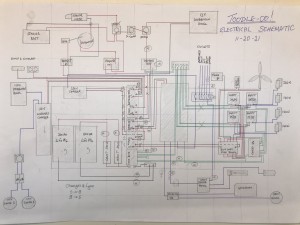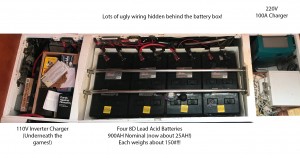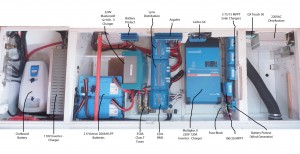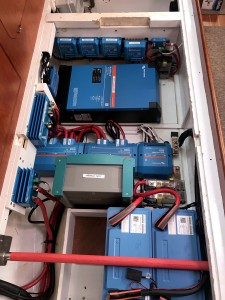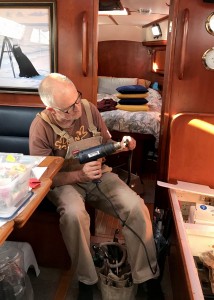My Lithium installation is complete! I ended up using all Victron kit – definitely not the cheapest, but with the information available on the web, theirs was the easiest to understand how to cobble together a comprehensive system. I also have numerous Victron folk knowledgeable about the Victron gear close by – and (though not close), Tim Chapman (currently cruising aboard Larus in New Zealand) was extremely helpful and steered me around very nicely.
Toodle-oo! was born a 110V AC / 12V DC boat, but the original owner installed a 220V Generator – along with 220V Watermaker, Water Heater and some outlets. He also added a 220V Shore power connection, making Toodle-oo! a very versatile boat for cruising within European waters. We had four 8D Lead Acid batteries, giving a nominal house bank of 900AH, which could be charged by 220VAC from shore or generator via 100A and 60A chargers in parallel, or by 110V Shore power via a 100A Inverter/Charger. A 260W solar array and a Silent(!)Wind turbine represented our ‘Green’ energy supply.
Our Lithium project had several objectives:
- Replace our desperate Lead Acid bank
- Reduce battery bank size and weight
- Take advantage of considerably faster charging rates
- Provide inverted 220VAC from the batteries
- Increase our solar capability
- Don’t blow up the boat!
After countless iterations of schematics, I finally settled on something I liked and purchased the requisite hardware from a local supplier of Victron gear (Algarve Solar), then set about dismantling the old and installing the new.
While Laurie had hoped that the conversion would allow some additional storage space, I pretty much commandeered the whole area for all the new goodies which included:
- Two 200AH LiFePO4 Victron Smart Batteries
- Lynx Battery Management System (BMS)
- The Lynx is much more expensive than other BMS’s but it is a BMS, Battery Monitor and Electronic Contactor all rolled into one neat package – which then can connect directly to the Lynx Distribution fused bus-bar arrangement
- Two Lynx Distributors
- Battery Protects (one 220A for house loads, two 65A for wind generator and alternator)
- Multiplus II 3kW Inverter with 120A Charger
- Argofet – to manage the charging from the alternator to house and start battery banks
- Four MPPTs – 3 for each of the new solar panels I hope to purchase, one for the existing solar array
- Cerbo GX Control hub – the communication heart of the beast
- GX Touch – a small display unit (which turns out to have limited practical use since the iPhone can pretty much do it all!)
- Loads of battery cable and lugs
Here’s the wiring diagram used to construct the system:
And we went from this:
To this:
You’ll see that I’ve left space for a third battery – just in case! Tim Chapman was pretty adamant that all we’d need would be twice what we use during the night – as during the day the solar should be able to fill the gap… As you can see, the size of the battery bank is much reduced from the old!
I can’t take credit for the neatness of the wiring – much as I’d like to! Stefan Ecke from s/v Mokendeist did all the 220V wiring and all the fiddly bits! He’s a magician!
Our hope is that with the faster charge rates and the new 220V inverter, we’ll be able to heat water and cook using our 220V Induction hob using the energy within the batteries – maybe that will take our power usage higher than the 400AH bank can cope with and the third battery may become a requirement. The whole thing still has to be tested and verified – and we’re currently somewhat hampered by the fact that I have been singly unable to entice the stainless-steel fabricator to come and have a look at what’s needed to mount three new solar panels above the bimini. It may just be that we postpone that project until a later date – which will actually give us time to evaluate if we really need that additional energy supply… (that’ll make Tim Chapman happy!)
If anyone has any specific questions about the installation, I’d be happy to steer them to someone that might be able to answer them! 😊
Now… back to some cruising posts!!!
Update: May 25, 2022. After cruising around for a couple of months…
I’ve ended up adding the third battery, bringing our bank to 600AH (12V) now. I did this because I was having to manage the whole thing so closely – with SOG going from 100% to 20% and back again all the time. Since adding the additional, our charge and discharge curves have been much more gentle.
The 680W solar array with the LFP’s has allowed us to – for the most part – do all cooking with the Induction hob and heat water via the batteries – noting that when we run the engine, we generate very hot water and that when the engine is run, we can utilize charge from the alternator if required. Also Laurie does utilize the propane from time to time – especially when the oven is called for.
Since adding the third battery we have not had to charge using the generator once and I have turned the alternators on maybe 50% of the time.
I do still manage the batteries closely, but I’m confident now that I could set it and leave it without worries about either over or under charging – and indeed we will shortly be off the boat for 10 days…

